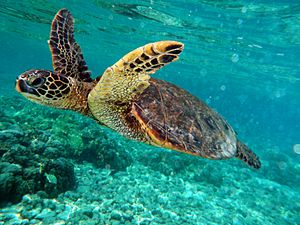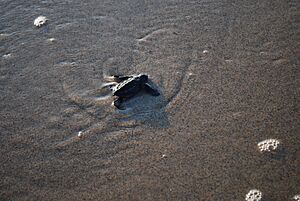Instinct facts for kids

Animals are born with special ways of acting called instincts. An instinct is a behavior that an animal knows how to do without being taught. It's like a built-in program! For example, a baby sea turtle knows to head for the ocean as soon as it hatches. This is because instincts are passed down from parents to their young, just like eye color.
Instincts are usually triggered by specific things in the environment, which scientists call releasers. Even though instincts are not learned, sometimes an animal can get better at doing them with practice. Other names for instincts are fixed action patterns or innate behavior chains.
Contents
What are Instincts?

Instinctive behaviors might seem simple, but they can be quite clever and change a bit depending on what's happening around the animal. If an animal does something without ever having learned it, then it's an instinct.
Think about these examples:
- Baby Sea turtles hatch on a beach and automatically move towards the ocean. Once in the water, they start swimming right away.
- A baby joey climbs into its mother's pouch right after it's born.
- Honeybees do a special "dance" to tell other bees where to find food, even though no one taught them how.
- Animals know how to fight, find a mate, or build nests without lessons.
Reflexes and Instincts
Some very quick actions are called reflexes. These are a special type of instinct. A true reflex happens so fast that the message doesn't even go to the brain! Instead, it travels to the spinal cord and then immediately back to the body part. This quick path is called a reflex arc.
Reflexes are similar to fixed action patterns, but fixed action patterns can involve the brain too. For example, a male stickleback fish gets aggressive towards anything red during mating season. This is an instinct. In humans, babies have primitive reflexes like rooting (turning their head to find food) and suckling (sucking), which are also seen in most mammals.
Growing into Instincts
Some instincts only show up when an animal is old enough. For instance, young birds can't fly when they are first born. But a week or two later, they can fly perfectly. You might think they "learned" to fly. However, experiments have shown that if young birds are kept from moving their wings until they reach the age when other birds fly, they can still fly immediately and normally when released. This shows that flying is an instinct that appears when their muscles and nerves are ready, not something they learn.
Instincts and Learning
Most behaviors are a mix of instincts and things an animal learns. For example, in something called imprinting, a baby bird learns who its mother is during a special time in its life. The famous scientist Konrad Lorenz had a baby goose imprint on his boots! After that, the goose would follow whoever wore the boots. The goose learned who its "mother" was, but the act of following was an instinct.
Similarly, sleeping is an instinct for humans, but how much and when we sleep can change based on our environment. Deciding if a behavior is mostly instinct or mostly learned is a big part of the "nature versus nurture" debate.
Why Instincts are Important
Instincts are like built-in guides that help animals survive. An animal doesn't have to think about what to do; it just does it automatically.
- A baby bird automatically opens its mouth wide and chirps loudly for food.
- Baby bats automatically cling to the cave wall.
- Butterflies instinctively know to lay their eggs on certain plants that their young will need to eat.
Animals are born with these instincts, and they follow them without having to consciously think about it. Animals can get behaviors in two main ways: by learning (through watching others or repeating actions that have good results) or by inheriting the behavior through their heredity.
Images for kids
See also
 In Spanish: Instinto para niños
In Spanish: Instinto para niños


